tire size CHEVROLET SUBURBAN 1994 Owners Manual
[x] Cancel search | Manufacturer: CHEVROLET, Model Year: 1994, Model line: SUBURBAN, Model: CHEVROLET SUBURBAN 1994Pages: 385, PDF Size: 19.88 MB
Page 198 of 385
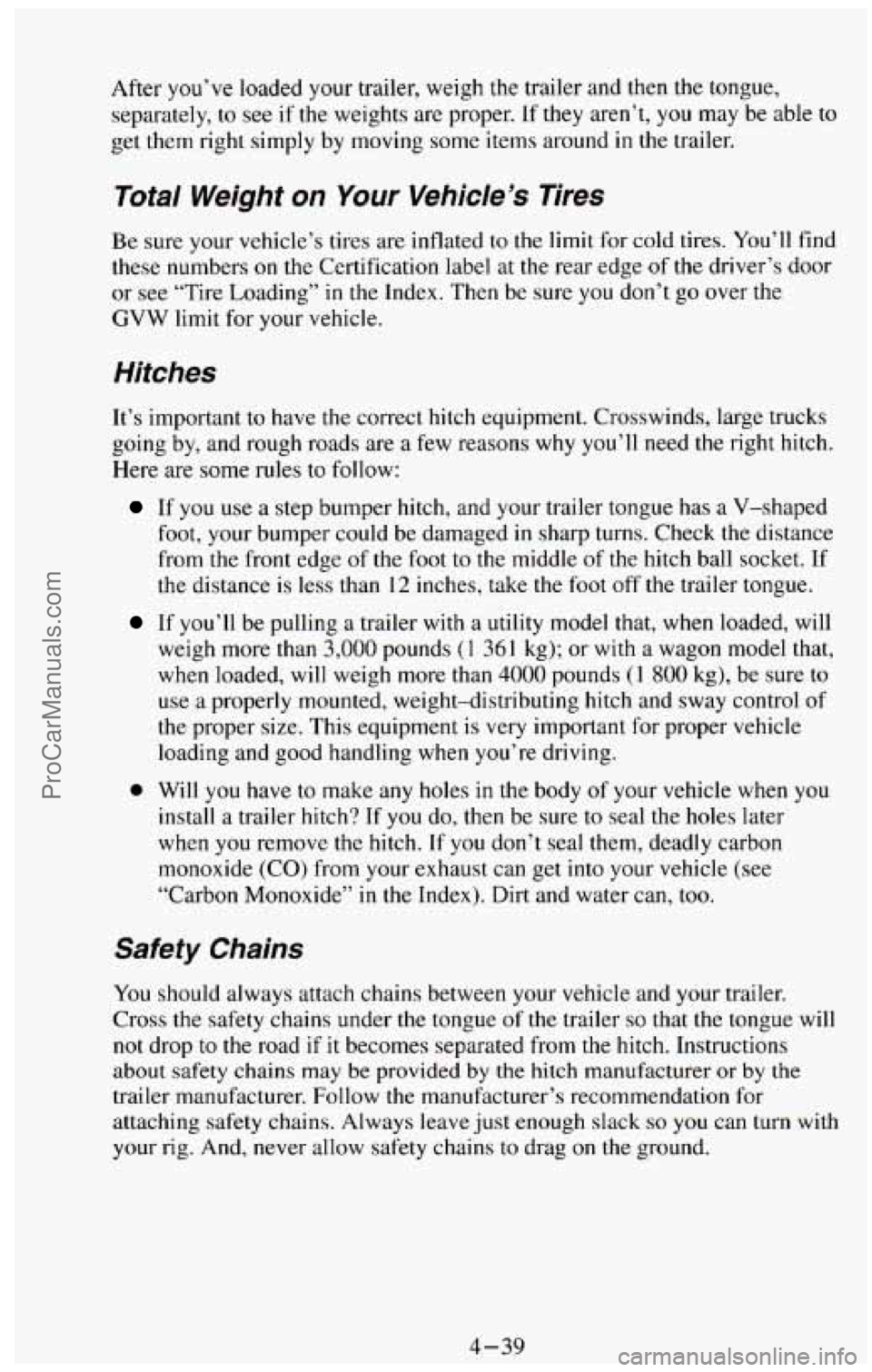
After you’ve loaded your trailer, weigh the trailer and then the tongue,
separately, to
see if the weights are proper. If they aren’t, you may be able to
get them right simply by moving some items around in the trailer.
Total Weight on Your Vehicle’s Tires
Be sure your vehicle’s tires are inflated to the limit for cold tires. You’ll find
these numbers
on the Certification label at the rear edge of the driver’s door
or see “Tire Loading” in the Index. Then be sure you don’t go over the
GVW limit for your vehicle.
Hitches
It’s important to have the correct hitch equipment. Crosswinds, large trucKs
going by, and rough roads are a few reasons why you’ll need the right hitch.
Here are some rules
to follow:
If you use a step bumper hitch, and your trailer tongue has a V-shaped
foot, your bumper could be damaged
in sharp turns. Check the distance
from the front edge of
the foot to the middle of the hitch ball socket. If
the distance is less than 12 inches, take the foot off the trailer tongue.
If you’ll be pulling a trailer with a utility model that, when loaded, will
weigh more than
3,000 pounds (1 361 kg); or with a wagon model that,
when loaded, will weigh more than
4000 pounds (1 800 kg), be sure to
use
a properly mounted, weight-distributing hitch and sway control of
the proper size. This equipment is very important for proper vehicle
loading and good handling when you’re driving.
0 Will you have to make any holes in the body of your vehicle when you
install a trailer hitch? If
you do, then be sure to seal the holes later
when
you remove the hitch. If you don’t seal them, deadly carbon
monoxide
(CO) from your exhaust can get into your vehicle (see
“Carbon Monoxide”
in the Index). Dirt and water can, too.
Safety Chains
You should always attach chains between your vehicle and your trailer.
Cross the safety chains under
the tongue of the trailer so that the tongue will
not drop to the road if it becomes separated from the hitch. Instructions
about safety chains may be provided by
the hitch manufacturer or by the
trailer manufacturer. Follow the manufacturer’s recommendation for
attaching safety chains. Always leave
just enough slack so you can turn with
your rig. And, never allow safety chains to drag on the ground.
4-39
ProCarManuals.com
Page 241 of 385
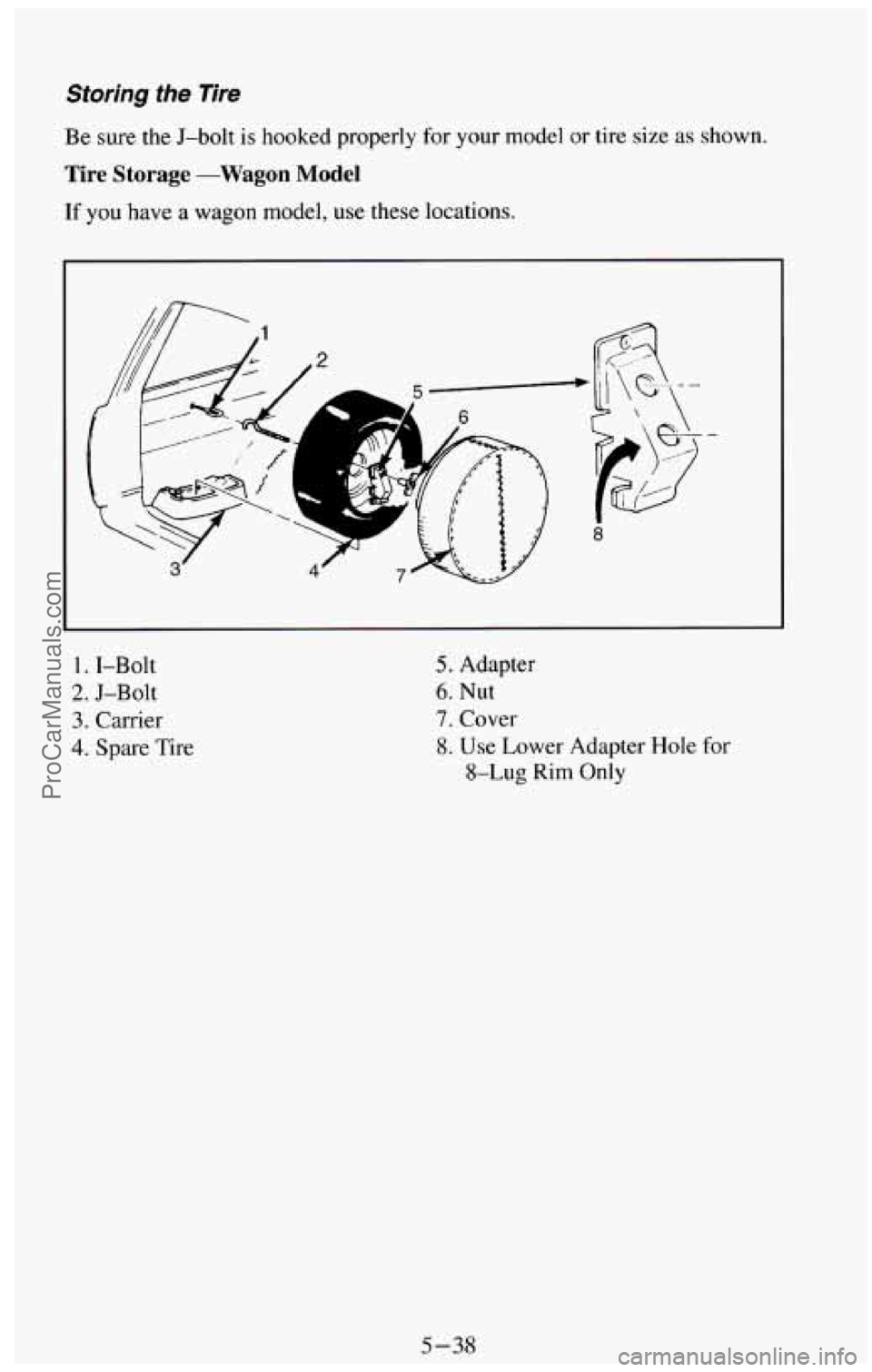
Storing the Tire
Be sure the J-bolt is hooked properly for your model or tire size as shown.
Tire Storage -Wagon Model
If you have a wagon model, use these locations.
1 , I-Bolt
2. J-Bolt
3. Carrier
4. Spare Tire
5. Adapter
6. Nut
7. Cover
8. Use Lower Adapter Hole for
8-Lug Rim Only
5-38
ProCarManuals.com
Page 304 of 385
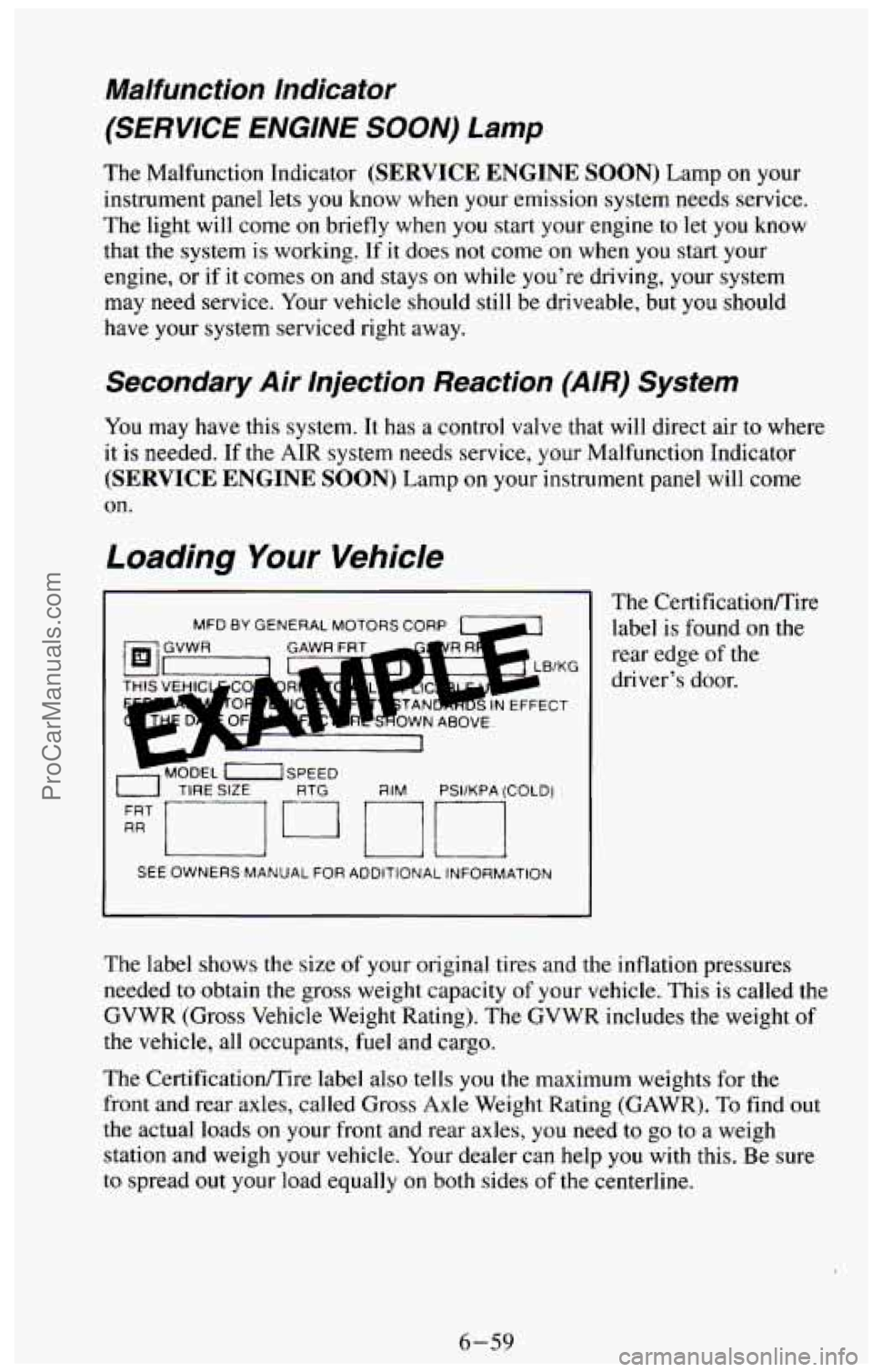
Malfunction Indicator
(SERVICE ENGINE SOON) Lamp
The Malfunction Indicator (SERVICE ENGINE SOON) Lamp on your
instrument panel lets you know when your emission system needs service.
The light
will come on briefly when you start your engine to let you know
that the system is working.
If it does not come on when you start your
engine,
or if it comes on and stays on while you're driving, your system
may need service. Your vehicle should still be driveable, but
you should
have your system serviced right away.
Secondary Air Injection Reaction (AIR) System
You may have this system. It has a control valve that will direct air to where
it is needed. If the AIR system needs service, your Malfunction Indicator
(SERVICE ENGINE SOON) Lamp on your instrument panel will come
on.
Loading Your Vehicle
MFD BY GENERAL MOT0 RSCORP
i IN EFFECT -
I
- MODEL [ISPEED w
u TIRE SIZE RTG FilM PSllKPA (COLD)
q----p nri
SEE OWNERS MANUAL FOR ADDITIONAL INFORMATION
The CertificatiodTire
label is found
on the
rear edge
of the
driver's door.
The label shows the size
of your original tires and the inflation pressures
needed to obtain the gross weight capacity
of your vehicle. This is called the.
GVWR (Gross Vehicle Weight Rating). The GVWR includes the weight
of
the vehicle, all occupants, fuel and cargo.
The Certificatioflire label also tells you the maximum weights for the
front and rear axles, called Gross Axle Weight Rating (GAWR).
To find out
the actual loads on your front and rear axles,
you need to go to a weigh
station and weigh your vehicle. Your dealer can help you with this.
Be sure
to spread out your load equally on both sides of the centerline.
6-59
ProCarManuals.com
Page 310 of 385
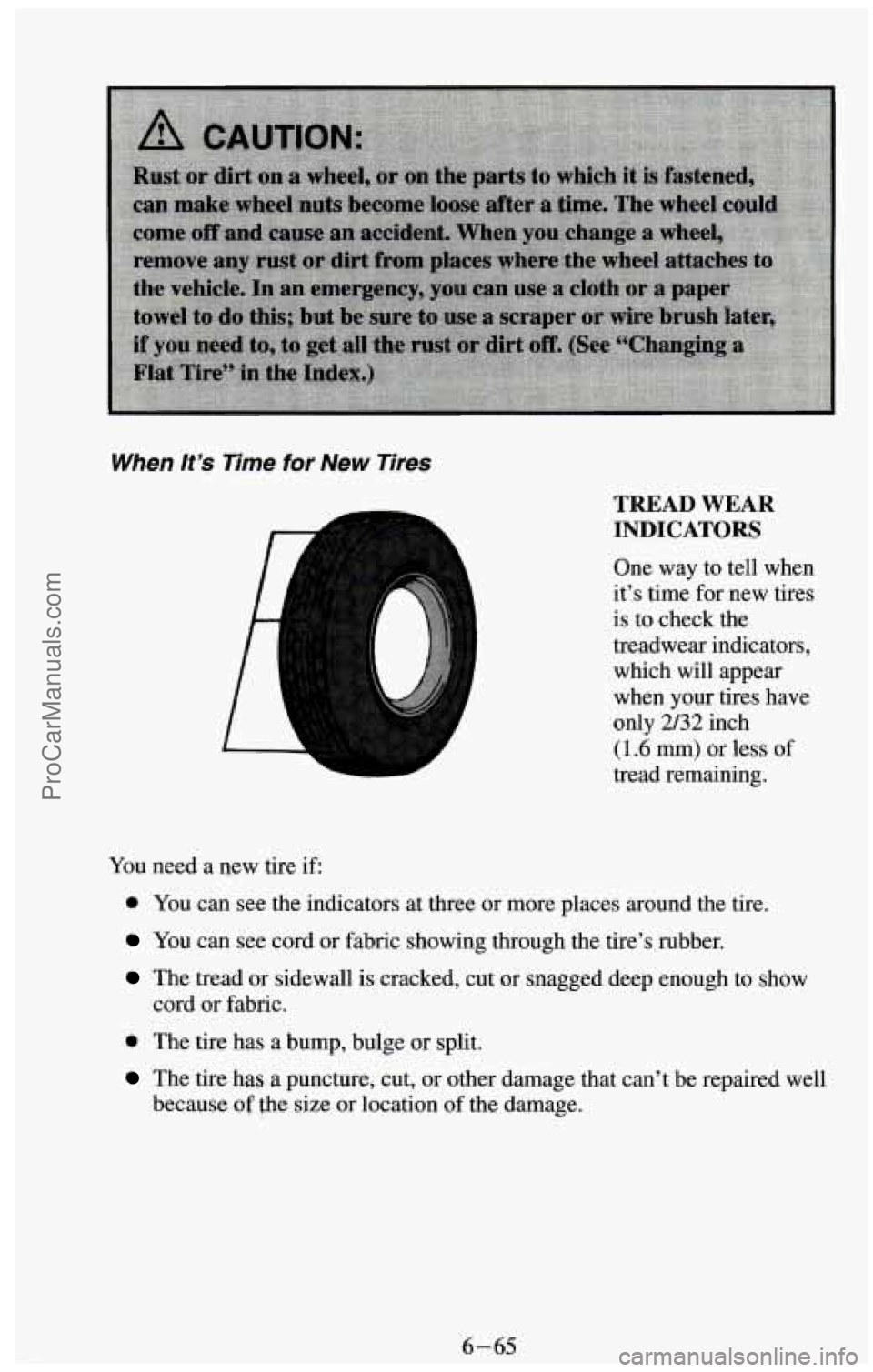
When /t ’s Time for New Tires
-L
E
TREAD WEAR
INDICATORS
One way to tell when
it’s time for new tires
is to check the
treadwear indicators,
which will appear
when your tires have
only
2/32 inch
(1.6 mm) or less of
tread remaining.
You need a uew tire if
0 You can see the indicators at three or more places around the tire.
You can see cord or fabric showing through the tire’s rubber.
The tread or sidewall is cracked, cut or snagged deep enough to show
cord or fabric.
0 The tire has a bump, bulge or split.
The tire has a puncture, cut, or other damage that can’t be repaired well
because
of the size or location of the damage.
6-65 ProCarManuals.com
Page 311 of 385
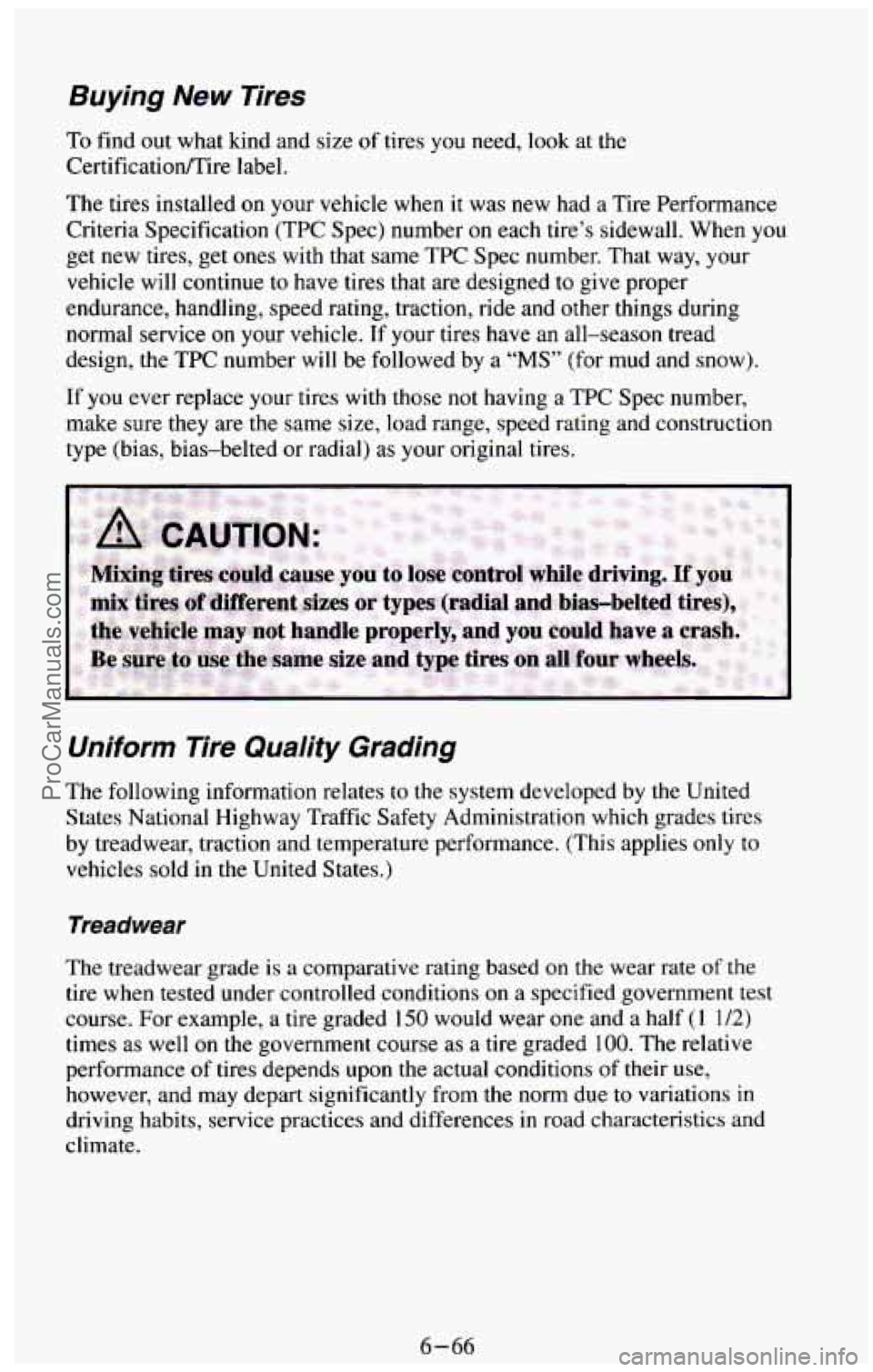
Buying New Tires
To find out what kind and size of tires you need, look at the
CertificatiodTire label.
The tires installed
on your vehicle when it was new had a Tire Performance
Criteria Specification (TPC Spec) number on each tire’s sidewall. When you
get new tires, get ones with that same TPC Spec number. That way, your
vehicle will continue to have tires that are designed to give proper
endurance, handling, speed rating, traction, ride and other things during
normal service on your vehicle. If your tires have an all-season tread
design, the TPC number
will be followed by a “MS” (for mud and snow).
If you ever replace your tires with those not having a TPC Spec number,
make sure they
are the same size, load range, speed rating and construction
type (bias, bias-belted or radial)
as your original tires.
Uniform Tire Quality Grading
The following information relates to the system developed by the United
States National Highway Traffic Safety Administration which grades tires
by treadwear, traction and temperature performance. (This applies
only to
vehicles sold
in the United States.)
Treadwear
The treadwear grade is a comparative rating based on the wear rate of the
tire when tested under controlled conditions on a specified government test
course. For example, a tire graded
150 would wear one and a half ( 1 1 /2)
times as well on the government course as a tire graded 100. The relative
performance of tires depends upon the actual conditions
of their use,
however, and may depart significantly from the norm due to variations
in
driving habits, service practices and differences in road characteristics and
climate.
6-66 ProCarManuals.com
Page 314 of 385
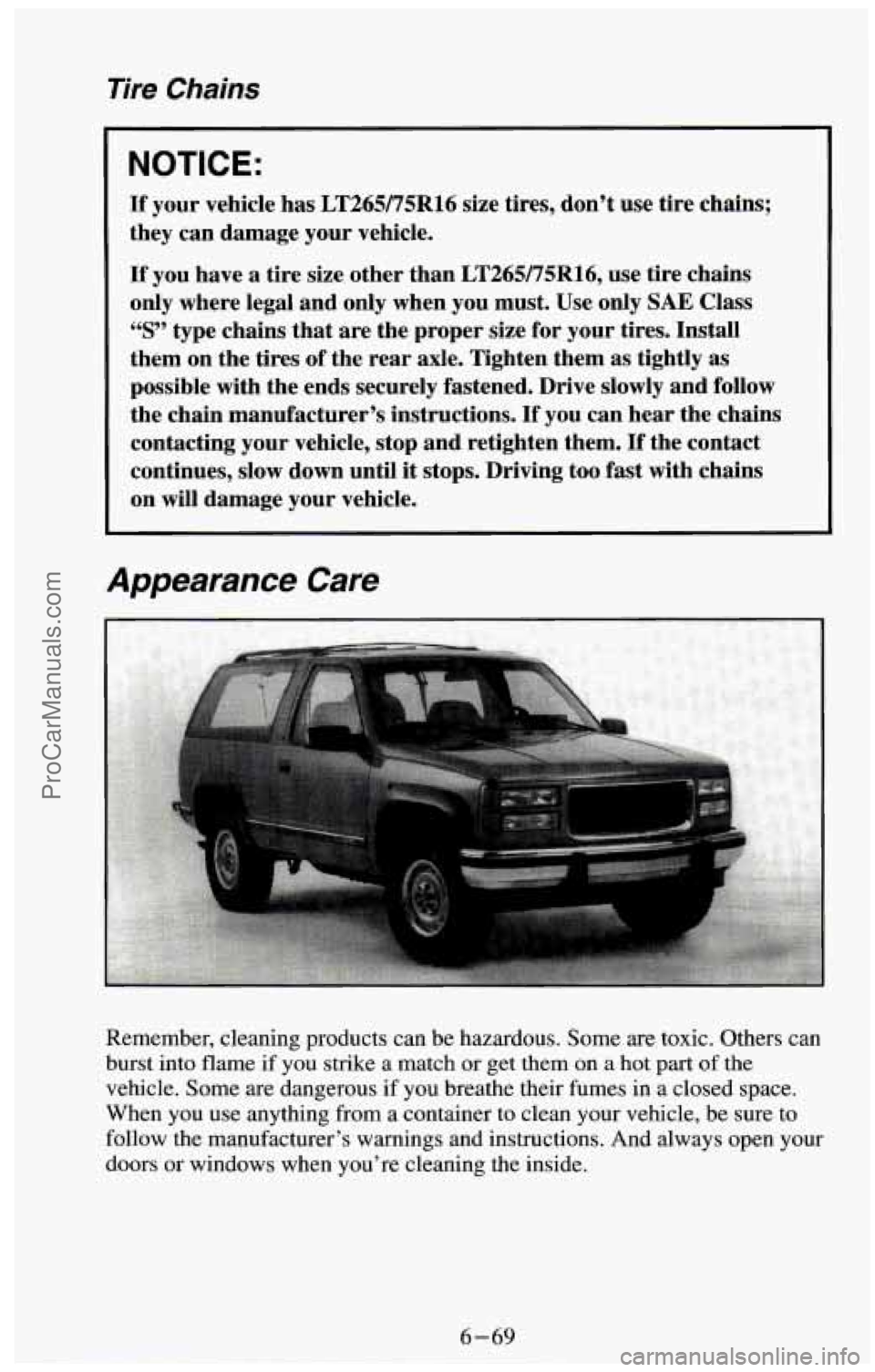
Tire Chains
NOTICE:
If your vehicle has LT265/75R16 size tires, don’t use tire chains;
they can damage your vehicle.
If you have a tire size other than LT265/75Rl6, use tire chains
only where legal and only when you must. Use only
SAE Class
“S” type chains that are the proper size for your tires. Install
them on the tires
of the rear axle. Tighten them as tightly as
possible
with the ends securely fastened. Drive slowly and follow
the chain manufacturer’s instructions.
If you can hear the chains
contacting your vehicle, stop and retighten them.
If the contact
continues, slow down until
it stops. Driving too fast with chains
on will damage your vehicle.
Appearance Care
Remember, cleaning products can be hazardous. Some are toxic. Others can
burst into flame
if you strike a match or get them on a hot part of the
vehicle. Some
are dangerous if you brea.the their fumes in a closed space.
When you use anything from a container to clean your vehicle, be sure to
follow the manufacturer’s warnings and instructions. And always open your doors or windows when you’re cleaning the inside.
ProCarManuals.com
Page 322 of 385
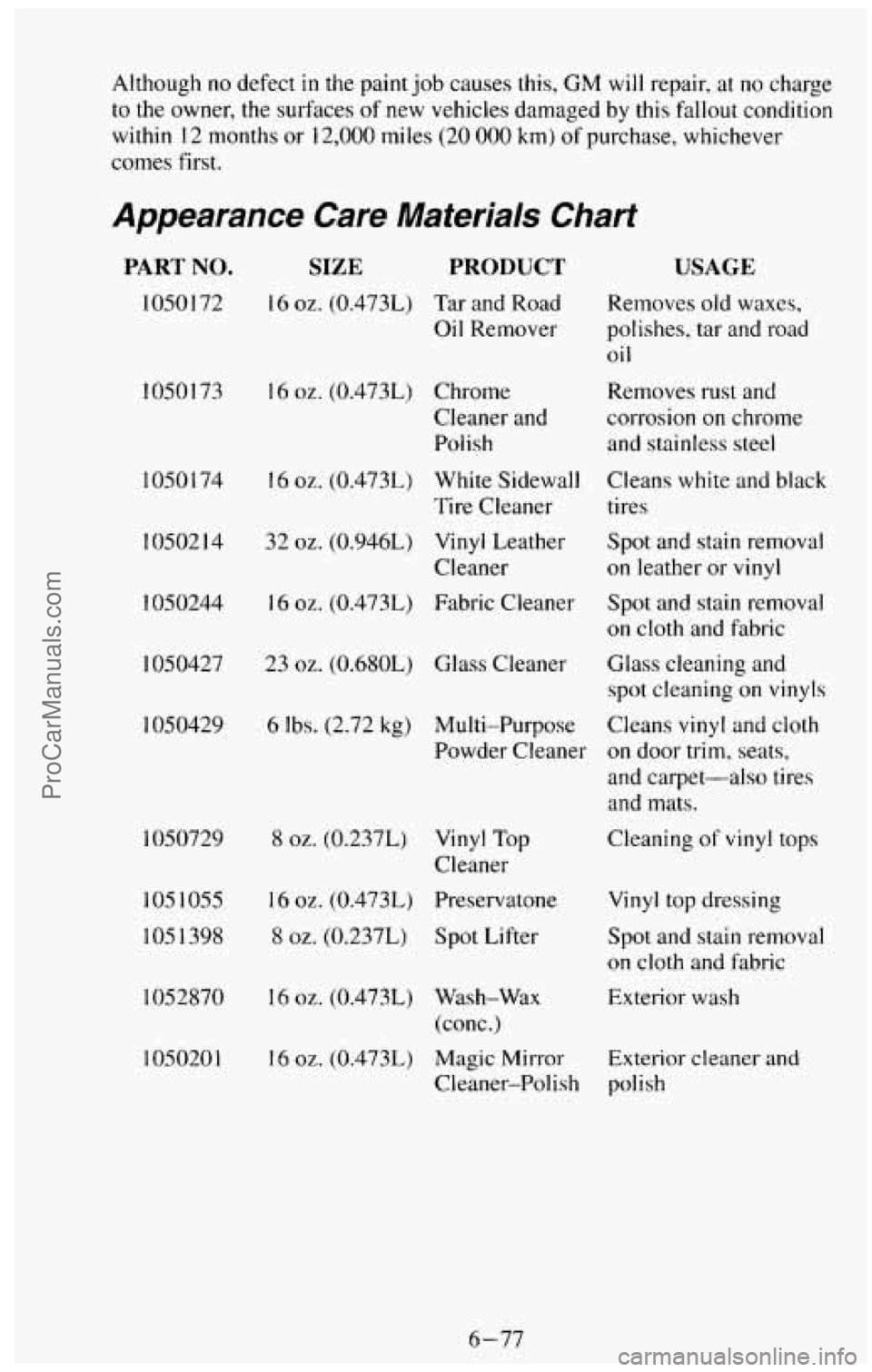
Although no defect in the paint job causes this, GM will repair, at no charge
to the owner, the surfaces of new vehicles damaged
by this fallout condition
within 12 months or 12,000 miles (20 000 km) of purchase, whichever
comes first.
Appearance Care Materials Chart
PART NO.
1050172
1050173
1050 174
1050214
1050244 1050427
I050429
1050729
1051055 1051398
1052870
105020
1
SIZE PRODUCT
16 oz. (0.473L) Tar and Road
Oil Remover
16 02. (0.473L) Chrome
Cleaner and
Polish
I6 oz. (0.473L) White Sidewall
32
02. (0.946L) Vinyl Leather
Tire Cleaner
Cleaner
16 02. (0.473L) Fabric Cleaner
23
oz. (0.680L) Glass Cleaner
6 Ibs. (2.72 kg) Multi-Purpose
Powder Cleaner
8 oz. (0.237L) Vinyl Top
16
oz. (0.4731) Preservatone
8
02. (0.237L) Spot Lifter
Cleaner
USAGE
Removes
old waxes,
polishes, tar and road
oil
Removes rust and
corrosion on chrome
and stainless steel
Cleans white and black
tires
Spot and stain removal
on leather or
vinyl
Spot and stain removal
on cloth and fabric
Glass cleaning and
spot cleaning on vinyls
Cleans
vinyl and cloth
on door
trim, seats,
and carpet-also tires
and mats.
Cleaning
of vinyl tops
Vinyl top dressing
Spot and stain removal
on cloth and fabric
Exterior wash
16 oz. (0.473L) Wash-Wax
I6 oz. (0.473L) Magic Mirror Exterior cleaner and
(conc.)
Cleaner-Polish polish
6-77
ProCarManuals.com